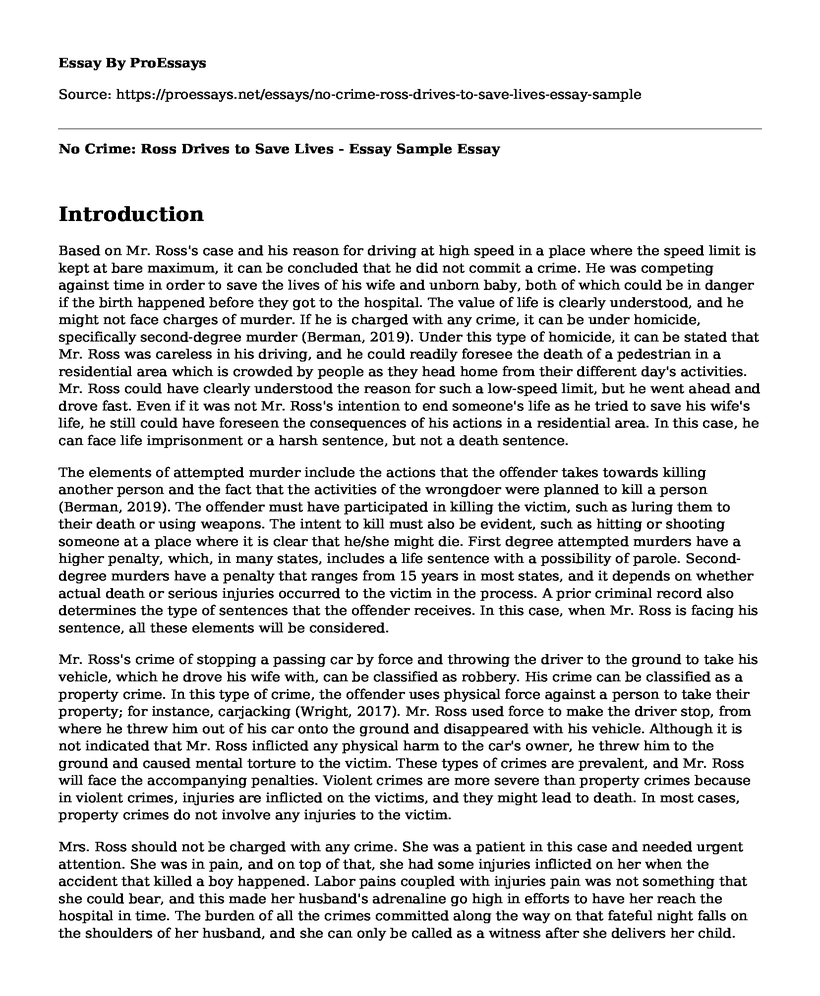Introduction
Based on Mr. Ross's case and his reason for driving at high speed in a place where the speed limit is kept at bare maximum, it can be concluded that he did not commit a crime. He was competing against time in order to save the lives of his wife and unborn baby, both of which could be in danger if the birth happened before they got to the hospital. The value of life is clearly understood, and he might not face charges of murder. If he is charged with any crime, it can be under homicide, specifically second-degree murder (Berman, 2019). Under this type of homicide, it can be stated that Mr. Ross was careless in his driving, and he could readily foresee the death of a pedestrian in a residential area which is crowded by people as they head home from their different day's activities. Mr. Ross could have clearly understood the reason for such a low-speed limit, but he went ahead and drove fast. Even if it was not Mr. Ross's intention to end someone's life as he tried to save his wife's life, he still could have foreseen the consequences of his actions in a residential area. In this case, he can face life imprisonment or a harsh sentence, but not a death sentence.
The elements of attempted murder include the actions that the offender takes towards killing another person and the fact that the activities of the wrongdoer were planned to kill a person (Berman, 2019). The offender must have participated in killing the victim, such as luring them to their death or using weapons. The intent to kill must also be evident, such as hitting or shooting someone at a place where it is clear that he/she might die. First degree attempted murders have a higher penalty, which, in many states, includes a life sentence with a possibility of parole. Second-degree murders have a penalty that ranges from 15 years in most states, and it depends on whether actual death or serious injuries occurred to the victim in the process. A prior criminal record also determines the type of sentences that the offender receives. In this case, when Mr. Ross is facing his sentence, all these elements will be considered.
Mr. Ross's crime of stopping a passing car by force and throwing the driver to the ground to take his vehicle, which he drove his wife with, can be classified as robbery. His crime can be classified as a property crime. In this type of crime, the offender uses physical force against a person to take their property; for instance, carjacking (Wright, 2017). Mr. Ross used force to make the driver stop, from where he threw him out of his car onto the ground and disappeared with his vehicle. Although it is not indicated that Mr. Ross inflicted any physical harm to the car's owner, he threw him to the ground and caused mental torture to the victim. These types of crimes are prevalent, and Mr. Ross will face the accompanying penalties. Violent crimes are more severe than property crimes because in violent crimes, injuries are inflicted on the victims, and they might lead to death. In most cases, property crimes do not involve any injuries to the victim.
Mrs. Ross should not be charged with any crime. She was a patient in this case and needed urgent attention. She was in pain, and on top of that, she had some injuries inflicted on her when the accident that killed a boy happened. Labor pains coupled with injuries pain was not something that she could bear, and this made her husband's adrenaline go high in efforts to have her reach the hospital in time. The burden of all the crimes committed along the way on that fateful night falls on the shoulders of her husband, and she can only be called as a witness after she delivers her child. The American College of Obstetricians and Gynecologists (2016) suggest the need to prioritize emergency cases of pregnant women, and this can be a strong point in addressing Mr. Ross's situation.
References
Berman, S. J. (2019). What is murder? Is murder different from homicide? NOLO. Retrieved from https://www.nolo.com/legal-encyclopedia/homicide-murder-manslaughter-32637.html
The American College of Obstetricians and Gynecologists (2016). Hospital-based triage of obstetric patients. Committee Opinion, no.667.
Wright, R. (2017). Property crime. Oxford Bibliographies. Retrieved from https://www.oxfordbibliographies.com/view/document/obo-9780195396607/obo-9780195396607-0016.xml
Cite this page
No Crime: Ross Drives to Save Lives - Essay Sample. (2023, Mar 21). Retrieved from https://proessays.net/essays/no-crime-ross-drives-to-save-lives-essay-sample
If you are the original author of this essay and no longer wish to have it published on the ProEssays website, please click below to request its removal:
- Laura Murder Case Paper Example
- UK Charity Hit by Cyber Attack: NCA Investigates Data Theft
- Essay Sample on Inter-Country Conflict: US & Mexico Border Crisis
- Essay Example on Protecting the US Homeland: The 2002 Emergency Preparedness Act
- Essay Sample on Jury Decision Making: Investigating Race and Interracial Elements
- Essay Example on Youth Gangs in Canada: A Sociological Study on Causes and Risks
- Essay Example on Due Process: Ensuring Equality & Fair Treatment Under the Law







